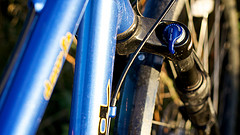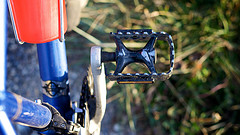I've been meaning to write a mini review of my 2008 Kona Dew FS, and figured after riding it for a year I'd have some thoughts on how the bike works as a daily commuter. I picked the bike up exactly 1 year ago today, and have ridden it to and from work in pretty much all kinds of weather (+30ËšC heat waves, monsoon thunder/hailstorms, blizzards, and -30ËšC cold snaps). In that year, I've put 4,800km on the bike.
Here's the bike on the day after I bought it:
One thing I learned is that the bike shop makes a HUGE difference. I went into Bow Cycle thinking I wanted a particular bike - I'd done some research on teh intarwebs and all - and wound up talking to a tech/sales guy there. Doug asked me what I wanted to do with the bike, what my ride was like, etc... and wound up showing me a bike that was several hundred dollars cheaper than what I came in looking for. He walked me over to the 2008 Kona Dew FS, which had apparently just come in, and we checked it out together. I took it for a quick spin, and bought it right there. I had the shop put on a rack so I could use my paniers, and fenders so I could ride in wet weather. I also had them switch out the seat for the one on my old bike - it's a cheap seat, but I've gotten used to it. All in, I think the whole thing cost me $850 - and they gave me almost $50 for my crappy old bike as a trade-in.
What impressed me in the shop was the big-ass 700c tires. My previous bike (a 1994? Scott Head) was heavy, creaky, and the wheels were set up for mountain biking - big knobby tires on normal-sized wheels. The Kona has the giant 700c wheels, and comes with tires more suited to commuting (some grip, but much closer to street slicks than knobby mountain shredders). What does that mean for a commuter? Much less roll resistance. You can pedal, and the giant wheels will coast. And coast. And coast. Whereas the knobby mountain bike tires would bump-bump-bump and stop.
The tires are also rather thin - meaning there isn't as much contacting the road surface, so there's less friction to slow you down on an even surface. This turns out to be exactly what you want on a commuter bike for most of the year, but can be a pain when riding on snow and ice because you don't have as much traction as you'd have with the fat knobby tires.
Another thing that impressed me right away was the range of gears. 3 gears in front, and 9 in back. For my ride, that's exactly what I needed. I have to climb (and descend) a whole bunch of hills, so being able to drop down to a very low gear meant I was able to do the ride. And also being able to shift into a very high gear meant the downhill stretches were more fun :-)
And the index shifters are great, and make it easy to pop up or down a gear very quickly and efficiently. The only trouble I had with the shifters was a result of needing to tweak the adjustment - when I first got the bike, they were fine, but slowly I needed to really jam the left shifter to upshift. I wound up damaging my left thumb from pushing it too hard, too often. Stupid me, though, because it took a tech maybe a few seconds to adjust the shifter in the shop, and that problem went away. Lesson learned: regular maintenance is a good idea. Once adjusted, though, they're rock solid. I can now shift and know the bike will respond. This makes crossing busy roads a bit less stressful, and also makes the long climb up the long hill on the way home just that much easier.
The other thing that attracted me to the bike at first was the disk brakes. Again, my previous experience was with a crappy Sport Check Special bike, and its brakes weren't very good. When wet, I'd blast through intersections because they didn't have any stopping power. Not with the Kona. The disk brakes are fracking awesome. They can stop me when riding about 40km/h, in maybe 20 feet. I could probably stop faster if I tried. And they work great when wet. I don't have to worry about losing stopping power. My bike will stop, assuming it's got traction. One thing I found is that the disk brakes become slightly less effective in very cold temperatures. They still work - and much better than my previous pinch-brakes - but less effectively than when warm.
The "FS" in the bike's model name stands for "Full Suspension" - it's got a suspension front fork, and a suspension seat post. I love the front fork, because it's also lockable. If you want a soft ride, or are going through some rough terrain (like construction zones, dirt paths, etc...) you open the fork so you have suspension on the front of the bike. But when you are on flat ground, and really want to give'r, you can lock it so it doesn't suck energy out of you by bouncing up and down as you pedal. It really does make a huge difference, so when I'm riding up a hill I just reach down and flip the switch to Lock. Before I get to the construction zone near my house, I just flip it to Open, and I get all of the suspension goodness. Best of both worlds (except the weight of the suspension fork doesn't go away when it's in Lock...)
[caption id="" align="aligncenter" width="240" caption="Open"] [/caption]
[/caption]
[caption id="" align="aligncenter" width="240" caption="Lock"] [/caption]
[/caption]
The suspension seat post is a love/hate thing with me. I do like that it softens the ride. But, I'm really not a fan of the wobble it adds to the seat - it actually causes the seat to rotate slightly around the vertical axis as you move. It's not the end of the world, but it can get annoying.
[caption id="" align="alignright" width="240" caption="no baskets here"] [/caption]
[/caption]
What else... Oh! The bike comes with toe baskets on the pedals, so your feet are nice and stable while pedaling. I used these for the first few months, and was getting used to them. Starting and stopping at traffic lights was a bit interesting, as you have to slide your foot into the basket to get it into place, and you can't always do that easily. When riding on slippery surfaces, I'd leave my feet out of the baskets, so the pedals were "upside down" when riding. That way, if I lost traction and started to go down, I could put my foot down more quickly, or swing it out for balance. That saved me from wiping out many times. But one afternoon, while riding through some deep snow, one of the baskets was ripped right off the pedal. I decided to remove the other one rather than replacing the broken basket, and found I liked riding the bike much better without the baskets at all. The pedals can be a little slippery, but the grips on my shoes (and in winter, boots) grips them well enough to keep my foot in place.
The only real "upgrade" I've done to the bike was to replace the rear tire. It wore out after about 2000km (because the rear of the bike carries most of the weight) and I replaced it with an Armadillo. Much better traction, and the tire seems to be relatively impervious to punctures - I've only had one flat with it since replacing the tire, and that was a torn valve stem not a puncture.
What I do know is that after 1 year, 4800km, 1 "dooring", several wipe-outs, a few flats, a couple of blizzards, and daily rides of 14km each way, I still love the bike. I'd definitely recommend it to anyone looking for a good commuter bike. It's not an offroad bike. But it's one hell of a great commuter bike.
Here's the bike after a year of wear and tear (and it needs some love - I'll give it a good scrub this weekend. promise!)


